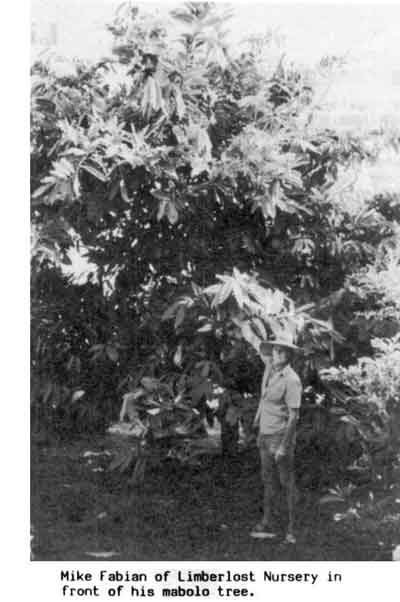
VELVET APPLE IN QUEENSLAND
SCIENTIFIC NAME: Diospyros discolor
FAMILY: Ebenaceae
Reaction on the velvet apple article by Gene Joyner in the March Newsletter came from Mike Fabian of Limberlost, who phoned me and wanted to add more details to Gene's article. I went to Limberlost to put Mike's comments on paper.
Gene's article was written for sub-tropical America where climatic conditions are different from ours in Queensland.

A Mr. Sorensen introduced the mabolo into Australia in the 1980s. In 1982, Mike Fabian acquired a grafted tree which is still growing strongly in the Limberlost property. The tree is about 8 metres high with a rather dense crown and produces prolifically year after year. This year's harvest was more than 500 fruits. The velvet brown-coloured fruits can grow out to a size of 15 cm and are seedless. When matured they turn from brown to red.
During this year's fruiting season, Limberlost promoted the fruit by giving them away at the counter to customers. The reaction on taste and flavour was almost always favourable.
Sometimes one can find mabolos for sale at the week-end markets. A lot of those fruits, however, are full of seeds and have little flesh. Mike often buys them, not to eat but to collect the seeds for propagation material. The only female tree at Limberlost has several male branches grafted onto it as to acquire some male fruits for the seeds.
Many hundreds of grafted female trees have been sold by Limberlost over the years. Mike finds the mabolo very hardy in our climate. His tree has never been on irrigation and withstood very hard winds. It is in fact an excellent backyard specimen that requires hardly any looking after.
The best way to know when the fruit is ripe is to wait till the fruits fall on the ground. The colour has turned pinkish by then. Keep the fruit for a few days before eating.
Mike also showed me his Pontin and Mangana mamey sapotes. Pontin is far more superior than Mangana in flavour. To know when the fruit is ripe, scratch near the main apex, if the flesh is pink then it is ready to be picked. Ripen for a week before eating. The fruit is then soft.
DATE: May 1995
* * * * * * * * * * * * *
